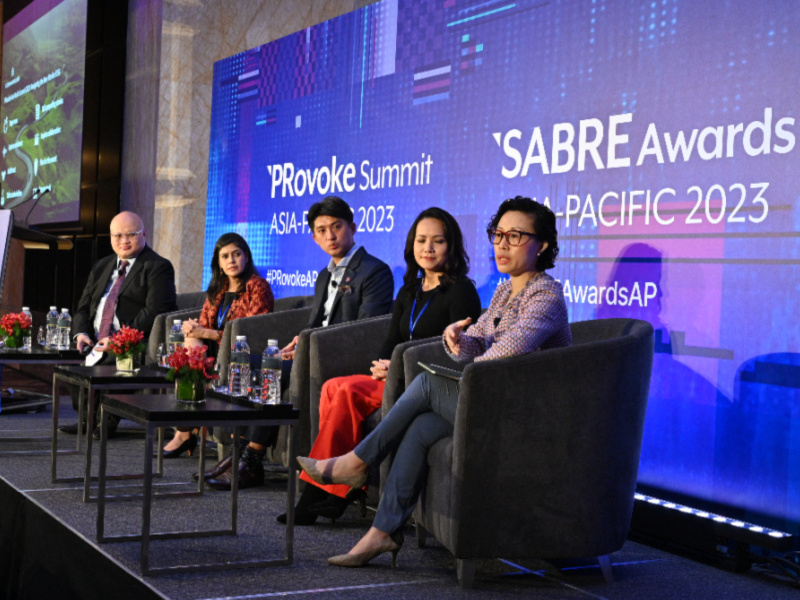Diana Marszalek 03 Oct 2023 // 12:30AM GMT

SINGAPORE — With ESG now an integral part of business strategy, communicators must take a multi-pronged approach to clearly conveying company initiatives — and their benefits to business and the planet — to get buy-in from stakeholders, from the C-suite to consumers, according to a panel of industry experts.
“I think it’s very important for us to align that moving forward ESG communications is not about campaigns. I’d like to debunk that,” said Angela Ling, LaSalle Investment Management’s Asia-Pacific director of marketing and communications. “Neither is it an ESG report.”
“For this to really work — to really be embedded and for us to see the results positively and the impact positively on the environment and on our societies — we need to the company, the entire company, to come along for the ride,” Ling said.
Ling was one of a panel of communications leaders who last week at PRovoke Media’s Asia Pacific Summit discussed the challenges and opportunities companies in APAC face in navigating ESG at a time when sustainability is not only good for the planet but a business impetrative as well. Other speakers were Shweta Shukla, Unilever International head of strategy, communications and corporate affairs; Sammie Leung, PwC Asia Pacific partner, regional ESG services; and Joachim Goh, the National Volunteer and Philanthropy Centre’s head of industry development and strategy.
The FleishmanHillard-sponsored conversation covered the gamut of topics related to ESG —making ESG relatable to consumers; communicating the business imperative of ESG to investors; reconciling new global standards related to disclosures with regional ones; creating alliances with governments and organizations; and bringing small businesses, like family-owned companies, up to speed among others.
Shukla stressed that ESG is no longer just good corporate citizenry but good business as well, saying that ESG is about "truly integrating" sustainable growth with business performance. "It’s not an either. It’s an and,” she said.
For Unilever, ESG is based around three commitments — improving the health of the planet, primarily through climate goals; improving people’s health, hygiene and confidence, which is tied to the company’s products; and ensuring DEI across its value chain and fairness in the workplace.
With that, though, comes communicators’ responsibility of driving awareness of the agenda while “making sustainability relevant to the common man and consumer” by explaining the likes of, say, how shampoo packaging contributes to reducing waste.
At the same time, communicators are responsible for demonstrating the business value of sustainability to other stakeholders by answering questions like how "reducing plastic helps grow our sales,” she said.
Shukla also emphasized the value in SMEs making their ESG initiatives — and successes — known, even when those steps are relatively small when compared to where big multinationals are at.
“We should avoid greenwashing but we should avoid greenblushing too,” she said. “Don’t shy away from talking about the baby steps you’ve taken.”
That is particularly true across APAC, where there are multinationals with sophisticated ESG programs in place as well as family-owned and other small businesses just starting to incorporate sustainability into their operations, panelists said.
Goh said that in working with SMEs on best ESG practices, the NVCP stresses the importance of smaller companies focusing their sustainability efforts on local needs.
“A lot of times people tend to look at global standards for a reference point. But what’s really important is for companies to address community needs,” Goh said. “Companies will do more strategically long-term.”
Leung, meantime, said that one of the key tenets of successful ESG communications is keeping things simple, particularly in light of developments the like International Sustainability Standards Board (ISSB) issuance of standards for sustainability-related disclosures earlier this year.
“There will be continued new frameworks and new terminologies which can be daunting and confusing,” Leung said. “It creates anxiety.”
However, it is key for communicators to stay focused on and leverage the opportunity that come with advancing sustainability, especially as business “will be creating a lot of the solutions,” she said.
“It’s a once in a lifetime opportunity for a lot of corporate functions, including comms, to take advantage of that,” she said.


































.jpg)


















